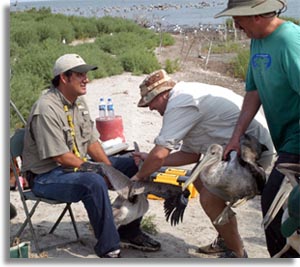|
June 12, 2007
 |
|
Louisiana DWF Photo |
Louisiana Department of Wildlife and Fisheries (LDWF)
personnel started work today on moving 100 to 150 brown pelican fledglings
from Last (Raccoon) Island to Whiskey Island on the Louisiana coast.
"Following the hurricanes of 2005, brown pelican colonies were impacted and
several were lost to erosive forces primarily east of the Mississippi
River," said Michael Carloss, LDWF Fur and Refuge Division biologist
program manager. "This project will help spread the brown pelican
population out that will in time produce more nesting sites and thus a
healthier pelican population."
The brown pelican translocation is the first year of a three-year
translocation project that will introduce new nesting colonies in the
vicinity of traditional brown pelican nesting areas. The hurricanes reduced
nesting potential on many remaining colony sites as a result of erosion and
reduction in land elevation from wave scouring.
This translocation project is being funded by a U.S. Fish and Wildlife
Service (USFWS) $200,000 grant. USFWS received a special congressional
appropriation for monitoring and conservation of wildlife in response to
the 2005 hurricanes. LDWF developed several grant proposals for hurricane
impact related projects.
"Supporting this project is essential to effective stewardship of this
protected species," said Jim Boggs, Field Supervisor for the Service's
Ecological Services office in Lafayette.
Boggs went on to say this effort "melds perfectly with our desire to also
try to replenish the coastal area with splays from the Mississippi to
replicate the natural land-building process so long altered by channelizing
the river."
Translocation is a proven wildlife management technique that will assure
quality brown pelican nesting sites west of the Mississippi River. LDWF
used this strategy from 1984 to 1986 when they translocated fledglings from
Queen Bess Colony to Raccoon Island. LDWF biologists estimated 3,600 brown
pelican nesting pairs at Raccoon Island on May 10, 2007.
Biologists are targeting young birds that still have about three weeks
before taking to the air; this will help ensure that they stay on the
island instead of returning to their original nests. LDWF is also tagging
some of the fledglings that will be used to monitor the project and future
research.
A University of Louisiana Lafayette doctoral student, who will have to feed
the pelicans daily for the first three weeks as they become accustomed to
their new surroundings, will monitor the relocated pelicans.
|
|
Please join us in our
Discussions forums with topics covering Wildlife Rehabilitation,
Birding, Backyard Wildlife and More.
|